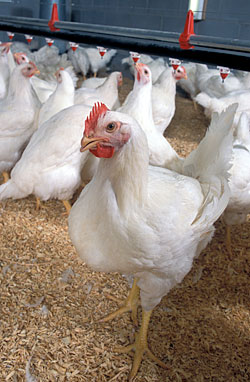 (USDA photo)
(USDA photo)
If you’ve ever fallen ill with a case of food poisoning, Big Food would like you to know that it’s probably your fault.
A few weeks ago, the U.S. Department of Agriculture issued new safety compliance guidelines for the poultry industry. They’re notable for several reasons: they drastically reduce the allowable levels of salmonella present and, for the first time, they address the issue of campylobacter, the second leading cause of food-borne illness in the United States after salmonella.
Current standards, for example, allow for up to 20 percent of poultry carcasses to carry salmonella. If adopted, the new guidelines — they’re in the public comment phase right now — will reduce that figure to 7.5 percent, or no more than 5 positive sample tests out of 51.
Want to hear some more encouraging news? The country’s poultry producers are, for the most part, beating those standards by coming in with an average contamination rate of 7.1 percent — according to the industry’s leading trade and advocacy group, at any rate.
Organizations such as the National Chicken Council and the American Meat Institute are adamant that little more can be done to reduce the levels of pathogen infection in animals because bugs such as salmonella and E. coli 0157:H7 are “naturally occurring.” When they suggest it’s up to consumers to reduce the risk of becoming ill by avoiding cross-contamination or cooking to specific temperatures, they’re performing a very delicate balancing act.
Yes, one should avoid cross-contamination of raw meats with other foods, particularly those that are meant to be served raw or are cooked already, but they’re deftly avoiding the deeper issue. Cross-contamination and lower cooking temperatures wouldn’t be such issues if the foods we were buying weren’t so contaminated already. The chances of pathogen-free food becoming contaminated in consumers’ kitchens, assuming consumers follow basic hygiene rules, are virtually nil. Chicken and ground beef don’t have to be crapshoots.
Last year, Consumers Union published its now-notorious study of contamination levels in commercially produced poultry carcasses. What they found was as startling as it was encouraging. While most of the conventionally produced poultry sold in the United States was infected with salmonella, one large-scale producer — Perdue — managed significantly lower levels of contamination than competitors Tyson and Foster Farms. And several organic producers were selling chickens free of both salmonella and campylobacter.
In other words, it is possible to raise chicken free of these pathogens.
Those improved numbers mean something a little less encouraging, however, according to the National Chicken Council. When I was working on a story about the new guidelines for Food Safety News last month, NCC Communications Director Richard Lobb told me the low-hanging fruit has pretty much been picked. In other words — and I am, admittedly, projecting here — the country’s largest poultry producers are quite content to leave things as they are unless they’re pushed to do more.
The new guidelines are not “a federal rule,” said Lobb, “but they might as well be.”
Meanwhile, the country’s beef and other meat producers are coming out against proposed legislation by New York Sen. Kirsten Gillibrand (D-N.Y.) that would add six more strains of Escherichia coli to the list of pathogens for which producers must test. They already test for E. coli O157:H7 and, as far as they seem to be concerned, that’s plenty.
“We do not believe that declaring non-O157 STECS to be adulterants will enhance the food safety system,” the American Meat Institute said in a statement published on its website, “and we think that application of such a policy could consume resources that could be better spent elsewhere to achieve meaningful food safety progress.”
The poultry industry feels pretty much the same way.
“Twenty years ago you’d say one-third of chickens had salmonella, and now it’s consistently under 10 percent,” Lobb said. “The contamination level is considered fairly low.”
Corporate interests would dearly love for “fairly low” to be the new “acceptable.” Throughout the raging debates over food safety during the past decade, the almost constant refrain of the country’s industrial food producers has been that food safety lies, ultimately, with the consumer. To some degree, I have to agree. A few fairly basic practices, for example, would go a long way toward eliminating or at least decreasing food-borne illnesses. Hand washing, for instance, and cooking and storing food properly. (You know the rule, “Keep cold foods cold and hot foods hot.”) People make dumb judgment calls about food all the time, but that isn’t really the issue here.
As long as Big Food is allowed to pin the blame on consumers, it will continue to produce food that is tainted at “acceptable levels” because it costs them less to do so, and as the industry insists, people’s primary interest is cheap food. However, consumers end up paying the costs of unsafe meat: not only financially but, often, with their health — and occasionally with their lives.



